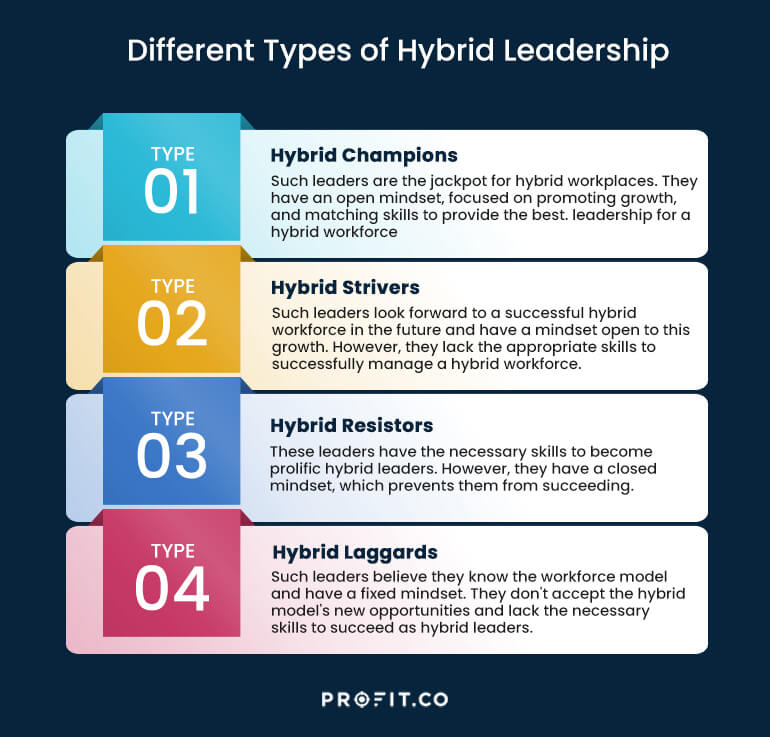Hybrid leadership calls for a different mindset and skills. These skills promote teamwork to ensure employees remain productive regardless of location.
The COVID-19 pandemic revolutionized the work environment. Companies had no choice but to switch from an office setting to a fully remote or hybrid workplace.
This change highlighted the need for effective leadership to manage the new challenges. Most leaders struggled with empowering and motivating remote teams, digital transformation, and uncertainty.
According to a study in the UK, nearly 75% of managers and leaders agree that leadership during the pandemic was questionable.
Post-pandemic, we have a new norm, and hybrid working is a crucial pillar. Leaders must develop and nurture skills to adapt to the changes and manage hybrid teams effectively.
In this article, you’ll learn the types of hybrid leadership, the necessary skills, the main challenges, and how to create effective Hybrid Team Leadership.
Key Takeaways:
- Employees are open to hybrid working, but there’s a gap in leadership
- Managing a hybrid model requires a particular kind of leadership
- The ideal hybrid leader must have an open mindset and the necessary skill set
- Hybrid-ready leaders view the workforce model not as a risk but as an opportunity to succeed
What is Hybrid Leadership?
During the pandemic, leaders discovered that employees could maintain productivity when working remotely. In some cases, the productivity levels were significantly higher than before the pandemic.
As normalcy resumes, most leaders aren’t willing to completely let go of remote working. The hybrid model aims to find a balance between the two work environments. It ensures the employees have the desired work flexibility and the advantages of a shared physical workspace.
Hybrid leadership is a new approach that focuses on diverse attributes such as:
- Psychological safety and health
- Creating self-awareness
- Conversational skills
- Emotional intelligence

What Are the Different Types of Hybrid Leadership?
There are four different types of hybrid leaders:
1. Hybrid Champions
Such leaders are the jackpot for hybrid workplaces. They have an open mindset, focused on promoting growth, and matching skills to provide the best leadership for a hybrid workforce.
2. Hybrid Strivers
Such leaders look forward to a successful hybrid workforce in the future and have a mindset open to this growth. However, they currently lack the appropriate skills to manage a hybrid workforce successfully.
3. Hybrid Resistors
These leaders have the necessary skills to become prolific hybrid leaders. However, they have a closed mindset, which prevents them from succeeding. They are capable of supporting a hybrid workforce, but they don’t believe their team can succeed in the hybrid system.
4. Hybrid Laggards
Such leaders believe they know the workforce model and have a fixed mindset. They don’t accept the hybrid model’s new opportunities and lack the necessary skills to succeed as hybrid leaders.
The ability to learn is the most important quality a leader can have.
What Are the Skills Needed for Hybrid Leadership?
A hybrid workforce ensures workflow through traditional settings and remote locations. Work allocation depends on demand to optimize engagement levels and productivity.
Although an open mindset is essential, other essential management skills include:
- Developing Clear Goals and Policies
- Proactive Communication with the Team
- Developing a Culture of Trust
- Creating Inclusivity, Team Spirit, and Purpose
Most hybrid teams struggle with ambiguity. Every team member must understand their role and responsibilities to prevent disengagement. As a leader, you should show this clarity in job descriptions, hiring and onboarding processes, and the company culture.
Leaders who master proactive communication and keep in contact with all team members. They understand the particular needs or requirements of every team member. Hybrid-ready leaders should be proactive and updated on the particular tasks the team is handling. Regular communication nurtures working relationships and a comfortable workspace. Before serious calls, you can try social-focused team meet-ups, virtual coffee dates, and small talk.
Hybrid leadership requires a sturdy foundation of trust. This trust at the workplace comes from creating deep connections and understanding individual team members. When there’s trust, you have confidence that your team can effectively resolve issues. The employees also believe that they have the right skills to create solutions. As a leader, you should avoid micromanaging team members, even when working remotely. The best way to achieve this is by adopting a coaching management style. Team coaching helps the team develop skills as a unit. It encourages teams to collaborate to find solutions to challenging issues at work.
Building a sense of belonging requires an environment where employees feel psychologically safe. Hybrid leadership involves creating a safe work environment to optimize performance. Team members feel purpose, passion, and drive when performing their tasks. Psychological safety means that team members are comfortable sharing new ideas. Recognizing these ideas makes them feel validated, valued, and motivated.
Top 5 Challenges of Hybrid Leadership
1. Virtual Relationship Building
Hybrid work is convenient when working from home, but co workers lack the chance to foster close relationships and trust. It can also lead to loneliness and feeling isolated. Hybrid leadership should promote regular virtual or physical interactions. For new members, pairing them with work buddies helps build connections.
2. Integrating a Remote-compatible Culture
For most companies, the hybrid work environment is a new concept that most companies struggle to sustain. Employees have a new perception of work flexibility. Companies must therefore work harder to create a remote-compatible culture. Organizations can explain through some hybrid culture examples of how it has been successful. This will go a long way in creating a positive outlook towards a hybrid culture. It’s necessary to ensure they can attract and retain top talent.
3. Lack of Effective Leadership
Since a hybrid work model is no longer a forced necessity, some leaders question its effectiveness. Closed mindsets are a real challenge because they can’t see the potential value. Some employees also resent hybrid work schedules due to isolation and lack of team spirit. You can overcome this challenge by encouraging virtual team collaboration.
4. Maintaining Connectivity between Home and the Office
Effectively managing a hybrid workforce further complicates the current team dynamic. Encouraging communication between teams can simplify some processes. Ensure you acquire efficient communication platforms that all members in a hybrid workplace can use and access from any location. Free versions often have limited usability, so it’s best to select subscription packages. Some platforms, such as Slack, are suitable for hybrid work at home. Task management tools ensure a hybrid workforce remains organized, accountable, and updated.
5. Balancing Task Allocation
In a hybrid workforce, employees working from home feel secluded because of their physical absence. It’s essential to strike a balance during meetings so that all members get an equal chance to participate. Leaders should also apply this balance when allocating resources, projects, and tasks.
You can get started on Profit.co completely free today to tackle the challenges of a hybrid workspace!
What Constitutes Effective Hybrid Team Leadership?
Effective hybrid team leadership requires leaders who can:
- Enhance Performance without Micromanagement
- Promote Employee Development
- Effective Communication
- Encourage Strong Relationships between Remote Workers and In-office Colleagues.
Leaders should ensure that the employees understand their responsibilities and performance metrics. Leaders should use a performance management system to evaluate the employee’s strengths and weaknesses. Once you’re confident in their skills, trust that they can handle their tasks and give them space to work.
Hybrid leaders should ensure that the employees have the necessary skills to enhance current and future productivity. Ensure you establish internal and external initiatives to promote growth. Also, offer proper mentorship equally to all team members.
Technological advances ensure virtual communication is as effective as one-on-one discussions. Traditionally, it’s easier to build a company culture, resolve conflicts, and address complex issues in person. However, hybrid leaders can handle such communication virtually since they have the right skills and open mindset.
Hybrid leaders should develop inclusive team environments. Collaboration channels help synchronize workflow among people with varying schedules or time zones.
Once you nurture psychological safety and trust, remote workers feel included. They can freely share their thoughts and participate in collaborative problem-solving.
Conclusion
Leading a hybrid team can be challenging, but you can enhance engagement and performance with the right mindset. This mindset encourages creativity, connection, ownership and accountability, and business agility growth. Hybrid leadership involves trust, psychological safety, and emotional intelligence. Enhancing these elements creates the right conditions for a more productive hybrid workspace. Book a free demo with our team to learn more about how OKR software can optimize your leadership capability and organization’s performance in a hybrid workspace!

